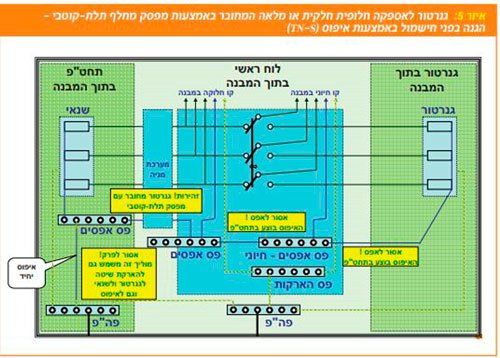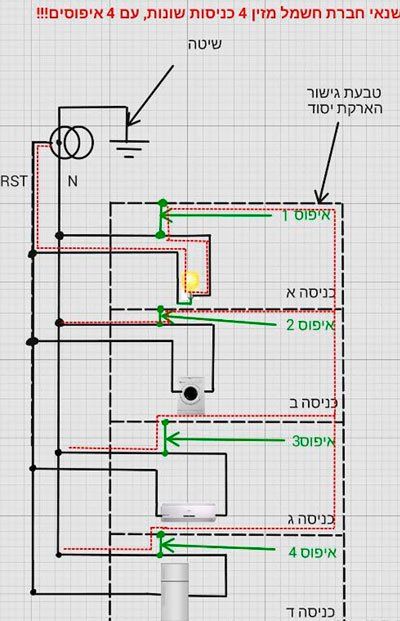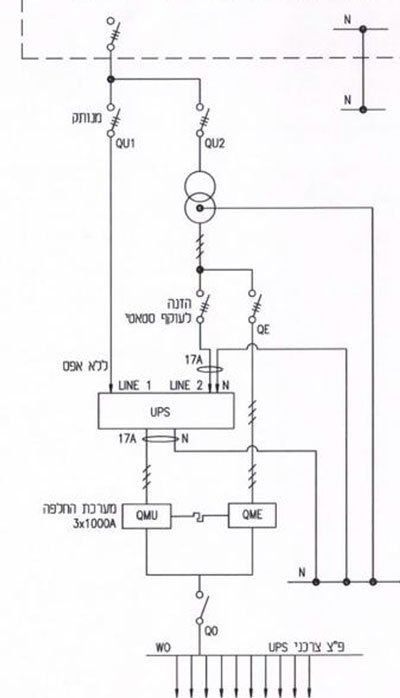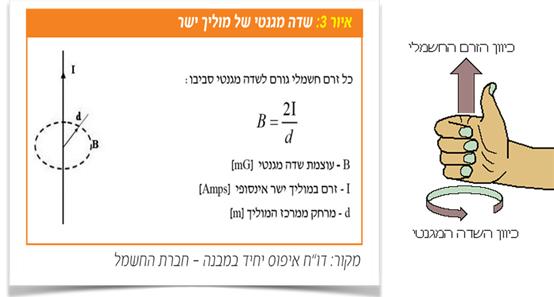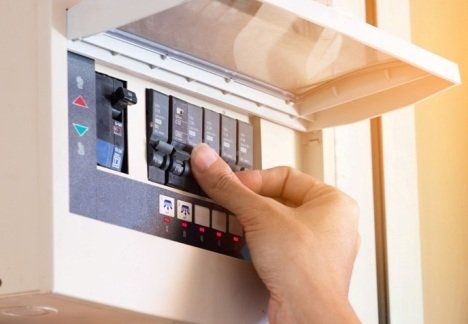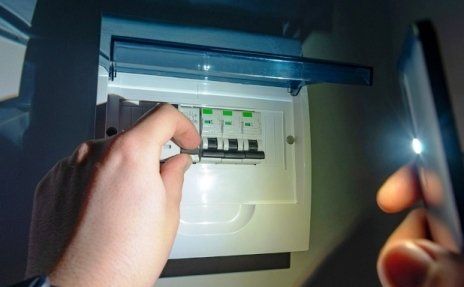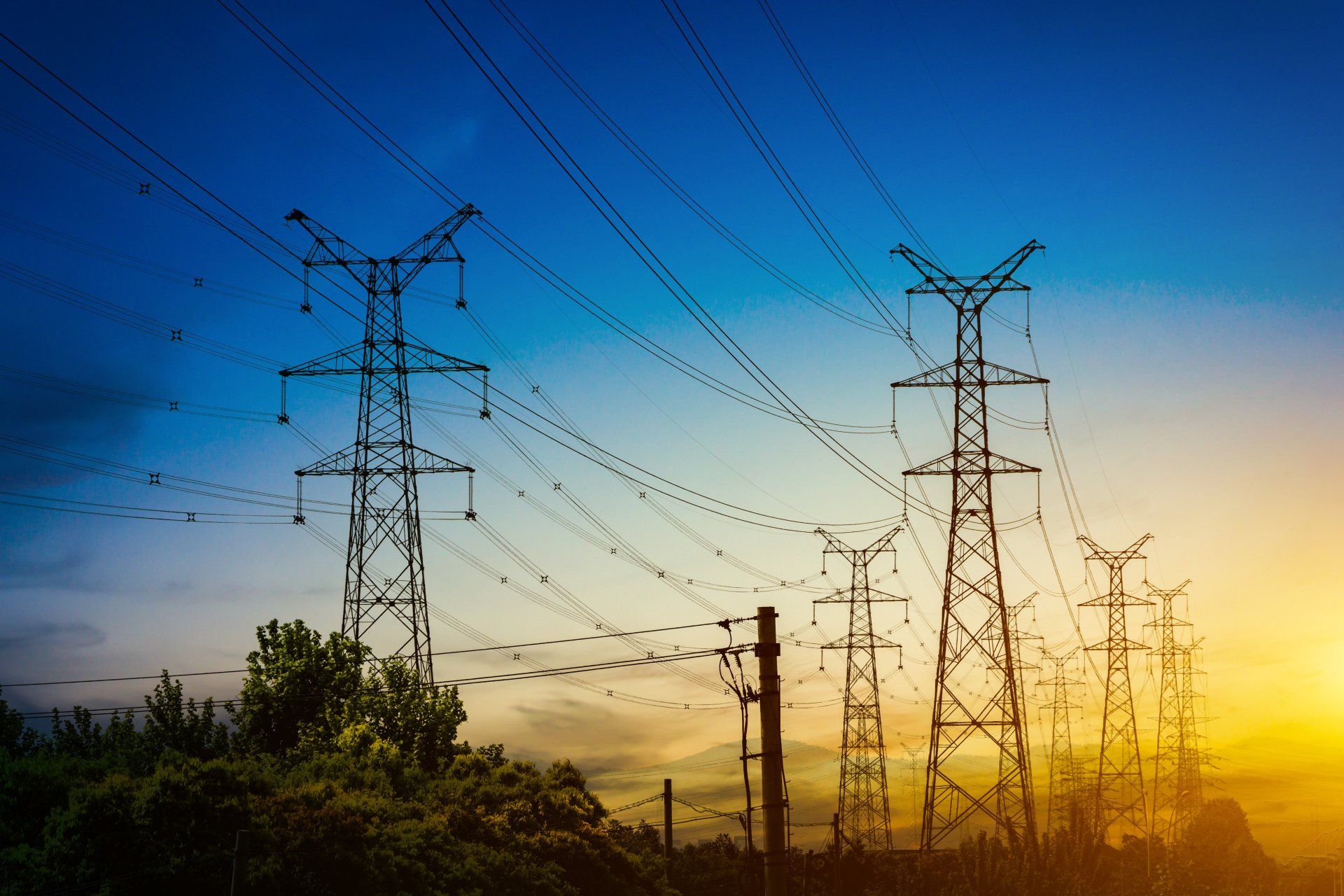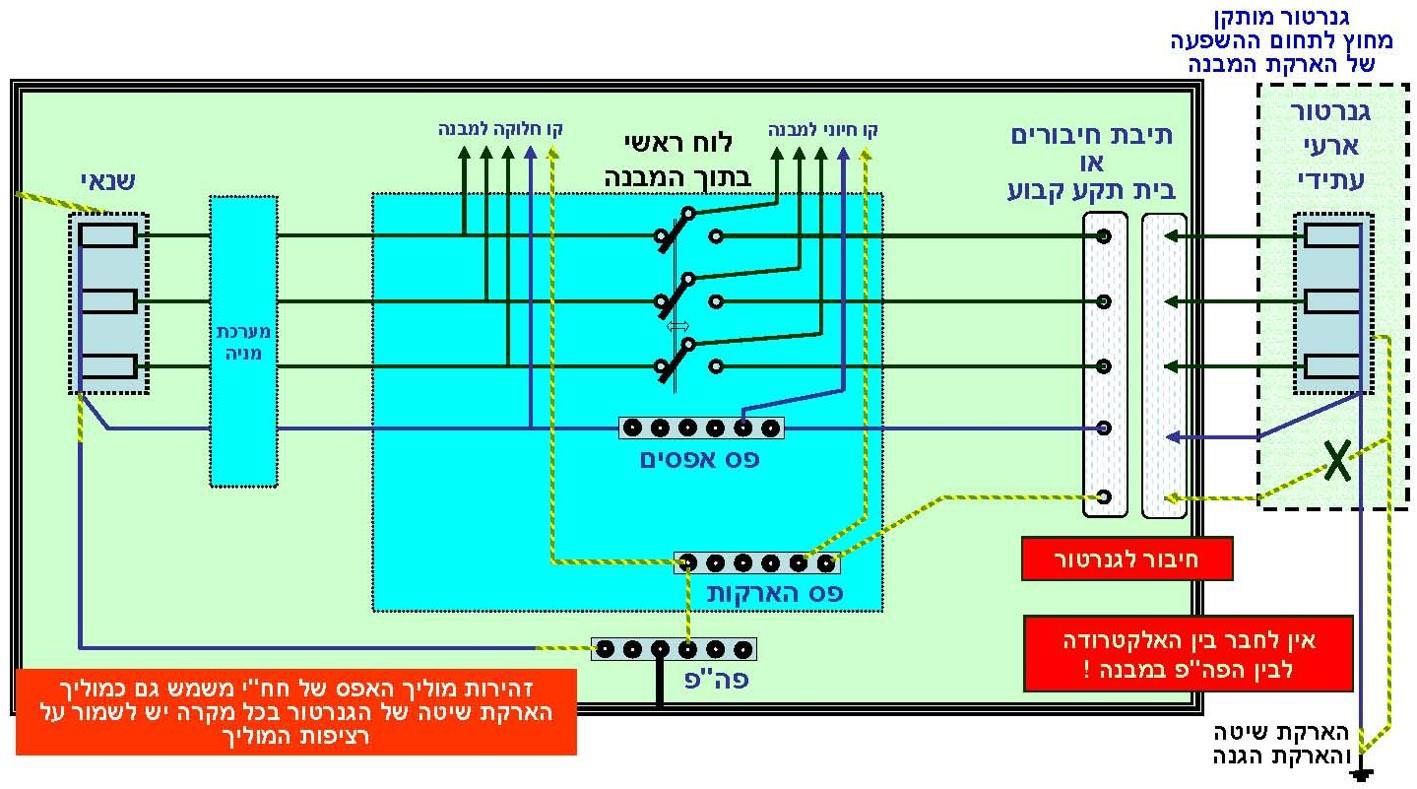Blog Layout
“Stray Currents” “Objectionable Currents” “Leakage currents” And what is in between them
יולי 24, 2019
The “chronic disease” of the industrial electricity infrastructure
ELECTRICAL SYSTEMS PROTECTION
Manufacture and Marketing of GES Systems

Table of Contents:
1. Introduction
2. The existing types of stray currents3. The causes of currents in grounding and leakage currents 4. The causes of stray currents without grounding involvement 5. The damages and risks from stray currents6. The legislation regarding stray currents 7. The existing solutions to the problem of stray currents8. The connection between stray currents and electromagnetic radiation9. The dangers of electromagnetic radiation (ELF)10. List of sources cited11. Summary
1. Introduction
Stray currents, as they are defined, are electrical currents whose path is not their natural and optimal route.
An optimum condition is when a power cord in which a current flow in a certain phase Towards the consumer, the same current is returned in the neutral conductor, in other words, a perfectly isolated electrical circuit from the ground and other electrical circuits.
But in reality, the situation is different. for example, a current that reaches a switch panel by a feed cable through the phase conductors should return, optimally, to the same feed cable by the “neutral” conductor.
If, however, for some reason, the current returns to the source through another conductor (grounding, neutral conductor of another cable, through any metallic fixture, or through the earth), This causes an imbalance in the feeder cable and the other conductor, as described before, also goes out of balance.
then these are stray currents.
Stray currents exist in almost every electrical infrastructure, industrial buildings and
Industrial infrastructure, in factories, schools, hospitals, office buildings, residential buildings and the public electricity lines.
As the electrical infrastructure carries a larger and more branched current, the danger becomes more common.
This situation causes major health and economic damages and real life hazards. Further in the article I will detail all the damages and risks that exist in the wake of the problem of stray and objectionable currents.
2.The existing types of stray currents
2.1. Leakage currents (leakage currents to ground)
2.2. Stray currents in electrical infrastructures, which do not involve grounding.
3.The causes of currents in grounding and leakage currents
3.1. Wear and loss of insulation between the phase and/or neutral conductors and the grounding - in this situation, the currents passing from the optimal electrical circuit leak to the ground, and through the ground or grounding conductors, return to the feed source.
3.2. Reasonable wear of the electricity infrastructure and the connected electrical appliances -
The factors are overheating and loosening of connections.
3.3. Water penetration or animal penetration. Thus, creating a connection with resistance, between a phase conductor and grounding.
3.4. Break fault in the enclosure.
3.4.1. One or more of the neutral busbar carriers is broken and falls on the structure of the grounded enclosure .
3.4.2. The wiring of the neutral conductors is attached to the case structure and may lose the isolation thus touch the conductive grounded area.
3.4.3. The door of the enclosure (switch panel) closes on a neutral conductive - due to dense and crowded construction of the enclosure.
3.5. An error in connecting and switching between the neutral conductor and grounding. I witnessed a number of cases in which an electrician made a mistake in connecting the neutral conductor to the grounding busbar and the ground conductor to the neutral busbar. The circuit connected in this way works normally because the potential differences between phase and neutral or between phase and grounding are the same.
3.6. Double grounded neutral (DGN) - A very common design error which may generate currents in groundings. DGN and sometimes even a large number of bonding in the same electrical installation.
The Israeli ELECTRICAL CODE explicitly states that only a single bonding must be performed in an electrical installation (grounding and protection means against electrocution - Chapter 7, Section 40 C)
However, since the laws and provisions regarding grounding and bonding are numerous and complex, and unfamiliar to many designers, the original design sometimes suffers from double bonding. Here are some examples:
3.6.1. As is well known, when connecting a generator, every generator is required to perform a grounding method, but when the generator's switching system, has three poles and not four (without switching the neutral) where there is basic grounding, bridging ring and equipotentiality and the generator is located under the same area of influence, it is forbidden to perform a grounding method for the generator because this constitutes double bonding (DGN).
(Source: Faza Acheret - connection configurations of fixed generators to alternative power supply)
3.6.2. Redundant bonding implemented in residential housing entryways with a TNCS protection method.
This is a common phenomenon when consumption from the electrical grid using the TNCS method, the PEN conductor must be connected to the Potential equalization busbar (bonding). This is also required if the fault loop test shows that the resistance is low enough to activate the protections. Then a situation is created whereby the current returning from the consumer to the main board splits at this point into two different directions reaching the feed source, the main part will pass through the PEN conductor, but a significant portion will pass through the earth and the grounding infrastructure, and even through the building's reinforcing steel.
I have encountered cases where, on the same constructive basis, with the same basic grounding and a bridging ground ring, the contractor built several entrances to residential buildings implementing bonding in each of them. This caused a lot of operational currents in the grounding and foundations, in the reinforcement irons, and to magnetic fields and strong electromagnetic ELF radiation.
The IEC has examined and mistakenly approved this building prior to populating, for almost 20 years.
Figure 1 Electrical bonding x4 in a structure sharing basic grounding
3.6.3. In a TNS-fed facility - additional bonding is performed at the entrance to the facility
When a structure electrical input is via TNS method, performing another bonding is completely redundant, it is DGN.
This is especially true when the designer does not pay attention to the source of grounding in the installation with the motivation to improve the grounding.
4. The causes of stray currents – without grounding involvement
4.1. Feeding a certain circuit from two different power sources simultaneously.
This is a fairly common phenomenon. Common causes:
4.1.1. Electrical works for customization - in places where properties are occasionally leased to various tenants, and in order to customize the property to the tenant's needs, the property may be divided in different ways. In these situations, electrical work should be performed to separate the properties and feed each part with its own electrical panel, canceling old feeds. In many cases the work is not handled professionally and meticulously. This may result electrical circuits that are fed simultaneously from two different electrical panels.
4.1.2. There are cases in which, due to a complaint about electricity shortage,
an electrician is called, who is not familiar with the local electric design.
So he hasn't found the circuit breaker went down, as a result he preferred to provide a new input feed from a nearby electrical panel board, without canceling the old feed.
At the first opportunity where someone passing by the electrical panel board, where the circuit breaker went down, turn it on, and then the circuit will be fed from two electric panels at the same time.
4.1.3. When performing lighting modifications, due to re-division of rooms, spaces, connections were found between the different circuits by a return phase only, and the neutral is left from the old circuit, a different lighting circuit. In this situation, a large part of the lighting fixtures is fed simultaneously from two different circuits. Phase from circuit “A” and neutral from circuit “B”
4.1.4. Electrical panels, involving two or more fields, that are not clearly separated, resulting in incorrect connections between the fields. In many cases where there is an electrical panel that contains more than one field, for example, a board divided into an essential field and a non-essential field, if the board is not clearly separated and properly signed, it is possible that when adding future circuitry, connections will be made involving the two fields.
Such as a phase from an essential field and neutral from a non-essential field. This phenomenon has caused a severe electric shock accident in the past, in which an IEC technician who disconnected a feed from a transformer on an to a structure that had a backup generator, received a return feed from the structure as a certain circuit was connected in that way. Disconnection of the feed into the structure disconnected only the neutral line to the circuit and it continued to receive a phase line from the generator. During the disconnection of the transformer, a voltage of 230V was created on the neutral line, which caused the disaster.
(Article by Roni Sinai - IEC)
4.1.5. Performing grounding methods TN, for two or more transformers in one installation, instead of direct bridging between the transformers' star point and connect the closest to the potential equalizer busbar, separate grounding method connections are made to each transformer, creating stray currents between them. (Assuming that the transfer switch does not cut off the neutral)
4.1.6. Connecting large UPS systems, where the neutral connection at the input and the neutral-conductor connection at the exit from the system are connected to the same neutral busbar. Since the UPS system has a galvanic connection between neutral entry and exit, it must be verified that these two have not been connected together outside the UPS.
This is a diagram of a case I encountered. At the exit of the UPS, a 3p transfer switch was installed, and the neutral point at the UPS exit was connected to the neutral busbar, to which the neutral conductor of the UPS system was also connected.
In this situation, 17 amps stray currents were measured at the entrance and exit of the system.
The customer was advised to replace to 4p transfer switch , as well as disconnecting the neutral.
4.1.7 When in one electrical installation, which has a generator backup, in which
The transfer switch does not switch
The neutral conductor, and there is more than one single panel with such
A transfer switch, so all the neutrals are connected
Among them in the facility. This creates a situation where an electrical
panel receives two neutral main conductors,
from two different feeder cables, at the same time. Then, currents returning
to the neutrals strip in the panel
Splits between the two neutrals and thus unbalances the two
Feed cables.
5. The damages and risks from stray currents
5.1. ELF electromagnetic radiation - Every case of stray currents, currents in grounding and leaking currents cause strong magnetic fields and ELF electromagnetic radiation. Magnetic fields emitted from any power cable are weakened in a quadratic proportion to the distance from them, while stray currents magnetic field weakens in a direct proportion to the distance from them.
As a result the level of electromagnetic radiation resulting from stray currents reaches much greater distances and constitutes a greater health hazard (see Electromagnetic Radiation Hazards)
5.2. Electrocution hazards - Stray currents cause electrocution hazards, the following are some examples:
5.2.1. An electric device (consumer) with a leakage to the ground has a severe insulation fault and therefore currents flow to the grounding. In this case, the current flowing to the ground may be too low to trigger the protections. This situation may pose two possible dangers:
1. When accidentally, or due to wear, the grounding is disconnected and then as the device becomes electrified and constitutes a real electric shock hazard.
2. Dangerous touch voltage on the conductive enclosure, and since the current flowing in the grounding multiplied by the grounding resistance (which in this case is probably high, otherwise the protection would have been triggered) dangerous touch voltage is generated.
5.2.2. An enclosure with a double bonding (for the purpose of explaining the danger that it poses, no matter for how it originated). In this situation there are supposedly two conductors that function as the neutral conductor and through which the current returns to the feed input source, through the neutral conductor and the grounding conductor. Now let's assume that for some reason the original neutral conductor is disconnected, in which case everything will continue to work normally, since the ground conductor serves as the neutral conductor and is now exclusive in this role. This may remain for a long time without noticing and without any indication. Then, in a situation that follows, a professional, such as a plumber or a repair contractor or an electrician, arrives, and due to some needs disconnects the grounding, and does not expect this electric conductor to have dangerous voltage, but once disconnecting the grounding conductor, the side coming from the consumer will have dangerous voltage (V230). This is a situation that could end badly. There were many cases of plumbers who were electrocuted when dismantling a water pipe, which apparently served as a grounding source and through which a current flowed before it was dismantled.
5.2.3. We often find cases in which a consumer, or a circuit, is connected to a phase from an essential field and neutral from a non-essential field or vice versa. This may result in a situation where one field is proactively disconnected, voltage will return from the other field, when this field is expected to be disconnected from the electricity. Then the electrician may risk electrocution.
Of course, a situation may occur even when one circuit is temporarily
fed from two different circuits.
5.3. Risk of fire - Suppose there is a double bonding occurred accidentally or by wear on an electrical panel or in some electrical enclosure, by conductors with relatively small cross-sectional area.
There are two major risks here:
5.3.1. Normally, high current may pass through these bond, sins part of the current will flow to the grounding conductor. A high current flowing in small cross-sectional area conductors will cause overheating, arcing and even fire.
5.3.2. During a routine check performed periodically by the inspector, he shall measure the impedance of the fault loop, and due to the double bonding, will receive a low result that does not reflect the resistance of the actual fault loop in the installation. Then, based on this result, he will tune the magnetic protection of the main switch, or will cancel the main leakage relay (which has been a great nuisance and occasionally went off due to this very double bonding) from here on, it is clear that there is no protection against a short circuit to the ground, and if such a short circuit occurs, the currents will be very high and there will be no protection. This situation may end with a fire.
5.3.3. In the case of lightning hitting grounding or in the event of short circuit to the grounding, much of the developing current will pass through the double bonding to the neutral conductor and from there to the connected electrical appliances, and this may cause irreversible damage to the device and, in the worst case, even a fire.
5.3.4. In the event that occurred in a test performed, a loose neutral wire was found inside electrical panel that touched the body of the board and generated sparks (due to a current flowing in double bonding). It is clear to all that sparks on an electrical panel may end in a fire, especially in explosive areas
5.4. Waste of energy – Unused grounded currents, is a waste of energy and increases electricity expenses. As explained in the previous sections, there are cases where the developing currents are not sufficiently high to activate the protections, and then relatively high currents flow consistently to the ground.
5.5. Interference with electronic, monitoring and measurement devices – often, shielded command cables (grounded shielding) are used to prevent noise from the surroundings, but what happens when high currents flow through the groundings and through the shielding? This causes high noises and disturbances to these devices.
In addition, the strong magnetic fields contribute to the intensification of these disturbances.
5.6. Repeated power outages - In places where the fault loop impedance is not sufficiently low to operate the protections, leakage relays are installed that are more sensitive to leakage currents and those, quite often, tend to cause frequent power outages when there are stray currents. The phenomena of a number of RCD that go off simultaneously without a clear explanation triggering of leakage relays and other protections.
5.7. Corrosion in reinforcement irons, water pipes and other metallic services.
(See article on Increased Corrosion due to Stray Currents)
5.8. Error in measuring the fault impedance loop (by an LT device) - When the test is carried out in an active place (not a new installation) the test is carried out without disconnecting the power, and if there is DGN, the result does not reflect the actual impedance of the fault loop.
To obtain a true result, power must be disconnected and the main ground conductor must be dismantled and tested offline, without being connected to the grounding strip.
Keep in mind that according to the result, the magnetic protection of the main circuit breaker is adjusted. Then, since the test has shown that the impedance is relatively low, the adjustment of the magnetic protection will be higher, and as a result, a real short circuit to the ground may occur, the protections will not be triggered and a large current will flow to the ground, which may, as mentioned, cause a fire and waste of energy.
6.The legislation regarding stray currents
The code, obviously, prohibits incorrect connections, double bonding, poor insulation and all other faults that cause stray currents. However, in practice there is no appropriate technological solution to the problem. In the vast majority of cases, even the routine tests conducted by electrical inspectors do not reveal the above faults. As described in the article, even the IEC makes mistakes that cause powerful stray currents.
7. The existing solutions to the problem of stray currents
Typically, in existing electrical installations, there is no warning of the above faults, and these faults multiply over time, both from faulty connections and breakage faults.
In most cases, the problems are discovered only after a disaster occurs or when a routine radiation test is performed. Then, the solution is usually the installation of partitions made of special materials to prevent the passage of radiation to where people are located, but this certainly does not solve the problem, but rather it is “swept under the carpet.”
The solutions available today are:
7.1. leakage relays (RCM- there are also multi-channel ones) which give an indication of leakage currents, but in a factory where there is a problem to stop production due to these alerts, in most cases these protections are bypassed and ignored.
7.2. RCD - The problem will be that a large number of RCD will be needed, and this will constitute a problem of space and heavy costs and many power outages
The technological solutions that existed to this day triggered an indication of leakage to grounding, but as we have learned from this article, there is a wide range of situations that may cause this, and existing solutions do not indicate the source of the fault and the cause. Therefore, due to lack of understanding by the owner of the facility, the alerts are turned off and production continues normally, being unaware of the risk involved.
8.The connection between stray currents and powerful electromagnetic radiation
Power cables contain the phase and neutral conductors.
In optimal mode, according to the first Kirchhoff law, the total sum of the currents on a cable should be equal to zero (where the current on the neutral is equal to and opposes the sum of the currents in the phases).
In this situation, the cable does not create a magnetic field around it, and in any case the field dissipates and disappears at a distance of several tens of centimeters. (the power of the magnetic field decreases in a quadratic proportion to the distance). This is because each wire creates a magnetic field around itself in a certain vector force, and at the sum of all the cable wires they cancel each other out and the total is neutral.
In the event that some of the current coming through the cable does not return through it, the balance in question disappears and the cable becomes a conductor holding a magnetic field around it, which is a function of the power imbalance in the cable.
This situation can occur when some of the current returns through the grounding or through another circuit to the input source.
In this situation the intensity of the magnetic field decreases in direct proportion to the distance!! And not in a quadratic proportion, such as when there is a balance.
In the case of grounding cables, which are not part of the circuit, in which no operating current is expected to flow. They are designed only of cases of failure, in order to prevent electrocution, to stream the current to the ground and activate the protections.
But when a current is flowing through them, and its power does not yet trigger the protections, then this grounding wire creates a magnetic field around it with intensity being a function of the current flowing through it.
Since in case there are stray currents and the protections do not work, there is no triggered indication and all the consumers are supposedly working as usual, there is a dangerous situation where people in the vicinity of the power cables are exposed to intense radiation levels for long periods and are exposed to their dangerous influence.
In most cases electric cables are embedded in the structure, above the ceilings or underground and in large lengths throughout the structure, but this does not prevent the magnetic fields from spreading out to a large radius. An office found above the ceiling where the power cables pass, the exposure may not be contained only to a specific room, but occasionally to a whole floor or a certain side of the building (depending on the path of the cable)
9.The dangers of electromagnetic radiation (ELF)
The Ministry of Environmental Protection has chosen the upper thresholds for permissible exposure as a compromise and a balance between the danger and the need for distance from radiation sources, and the ability of Israeli society to finance activities for this purpose.
It is based on the precautionary principle and for the reduction of areas where building restrictions apply due to the danger of radiation.
The goal of the Ministry is to minimize, as far as possible, by existing technological means, at a reasonable cost, the public's exposure to levels of electromagnetic radiation.
At present, there are no mandatory laws or regulations that determine the thresholds of permissible magnetic field strengths. However, the following recommendations exist: Acute momentary exposure of up to 1000 milligauss and up to 4 milligauss for average continuous exposure per day.
There are regulations regarding the design of new facilities and receipt of permits, in accordance with the expected levels of radiation from the electricity generation and transmission systems.
What is missing in the Radiation Law and/or the recommendations is a reference to the situation in which electrical faults will occur in the above systems, which, in the future, will lead to an increase in radiation levels, well above the calculation at the time of receipt of the permits.
The Ministry has formulated a committee of experts on magnetic fields from the electricity grid, and a report on their behalf was submitted in March 2005.
The committee received information that exposure to radiation over 4 milligauss increases, 2-fold, the probability of morbidity in children's leukemia.
The graph shows the maximum permissible radiation level relative to the exposure time:
In 2013, by government decision, the “Tnuda” Center was established, aiming to gather as much information as possible on this subject. The head of the Center is Prof. Sigal Sadezky, director of the Epidemiology Unit for Cancer and Radiation at the Gertner Institute.
The following is a quote from the site that describes the relevant information:
“The impact of long-term exposure to low-frequency electromagnetic field power on public health has been in study for over 30 years, since the pair of researchers, Nancy Wehrtheimer and Ed Leeper, found an increased risk of developing leukemia in children up to the age of 19, where relatively high current was measured in their houses, that was linked the phenomenon to the magnetic field generated by the electric current.“
10. List of sources cited
10.1. Damada website, article on the electromagnetic field - Part 1.
10.2. Faza Acheret information booklet – Generators’ connection configuration…
10.3. Faza Acheret information booklet – Electric shock due to return of voltage to the grid
10.4. The Electricity Law
10.5. Ministry of Environmental Protection Website
10.6. The “Tnuda” Website
11. Summary
In conclusion, I would like to emphasize and remind all of us that the inevitable progress always brings along new risks.
If there were no electricity or cell phones, there would not be so many sources of radiation, and if there were no vehicles, there would be no traffic accidents.
This article highlights a long-standing chronic problem in the industrial electricity infrastructure, with no suitable technological remedy. The time has come for this issue (of stray currents causing a wide range of dangers) will come up and be treated from its root. Today it is possible. our solution
The GES system can monitor these currents and even indicate their location and source in the electricity infrastructure.
Although we compromise regarding the risks that come with progress, but the dangers described in this article can and should be prevented.
For more information: ESP Home Page
בלוג חשמל
פרטי התקשרות:
מייל:
office@esp2018.co.il
טלפון:
050-2741329
כתובת למשלוח דואר:
ת.ד 2684 מיקוד 7512602 ראשון לציון
המשרד הראשי:
טוליפמן 7 ראשל"צ -בית רשתות
- למה יש מתח בין אפס להארקה
- מגן מתח יתר
- מגן נפילות מתח
- מדידת אנרגיה
- מה ההבדל בין אפס והארקה
- מכשיר לבדיקת זליגת חשמל
- מכשיר לבדיקת לולאת תקלה
- ממסר זליגה
- מתח בין פאזה להארקה
- נחשולי מתח
- נפילות מתח
- נפילת חשמל בבית
- קרינה אלקטרומגנטית מסוכנת
- הגנה מפני נחשולי מתח וברקים
- הגנה על מכשירי חשמל
- הגנות חשמל
- בקרת מבנה
- הרמוניות חשמל
- זרמים תועים
- חישוב זרם קצר לולאת תקלה
- חישוב מפלי מתח על כבלים
- לולאת התקלה
- טבלה לבדיקת lt
- טבלת לולאת תקלה
- אוגרי נתונים
- עכבת לולאת התקלה
- ערך בדיקת lt
- קפיצות חשמל בבית
- קפיצות מתח חשמל
- קצר חשמלי
- קרינה אלקטרומגנטית מסוכנת
- אחזקה חזויה
- איך לבדוק זליגת חשמל בבית
- איכות החשמל
- איפוס כפול
- איתור תקלות חשמל
- בודק הארקה
- הארקה בבניין ישן
- הארקה בדירה ישנה


